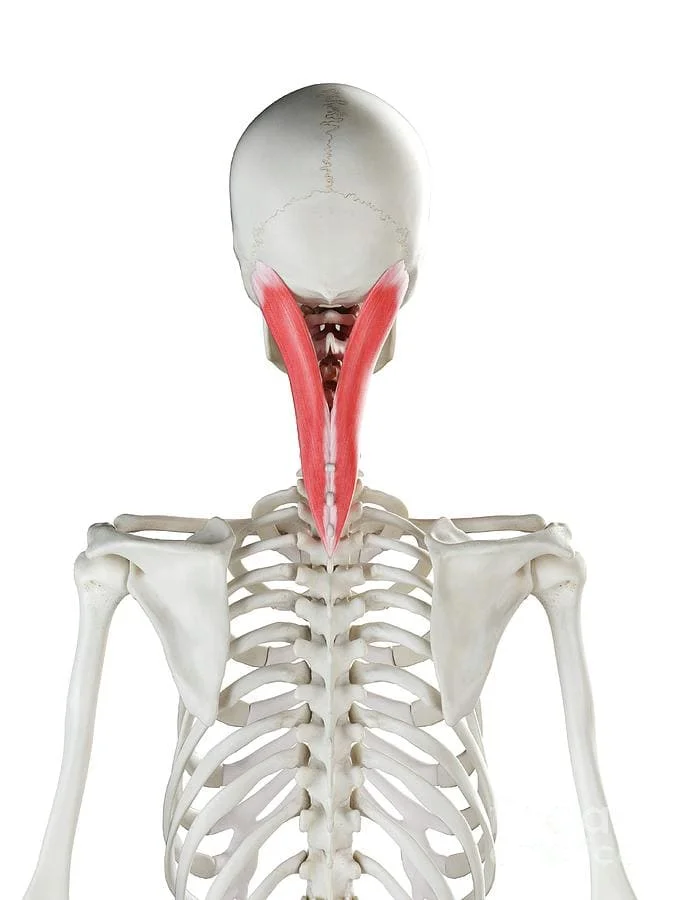The longus capitis muscle is one of the four deep muscles of the anterior neck. It originates from the transverse processes of the third to the sixth cervical vertebrae and inserts onto the basilar part of the occipital bone.
What Is The Longus Capitis Muscle?
A deep anterior neck muscle that runs in front of the cervical spine is called the longus capitis. It forms the prevertebral layer of neck muscles along with the rectus capitis anterior, rectus capitis lateralis, longus cervicis, and anterior scalene muscles. The cervical fascia’s prevertebral layer encircles these muscles as well. Bilateral contraction of the longus capitis muscle flexes the head and neck, while unilateral contraction oppositely rotates the head.
Its superior side is situated in front of the rectus capitis anterior muscle, while its inferior part barely touches the longus cervicis muscle. The lateral border of the longus capitis muscle is where the retropharyngeal lymph nodes are situated. The space between the scalenus anterior and longus capitis muscle attachments is traversed by the anterior vertebral vein and the ascending cervical artery that it borders.
The cervical spine is encased in a tubular sheath composed of the prevertebral layer of cervical fascia, which runs from the base of the head to the body of the third thoracic vertebrae, along with the other prevertebral muscles.
Origin
The anterior neck’s longus capitis muscle is a long, flat muscle. It runs parallel to the vertebral bodies over the whole length of the cervical spine. Four little muscular straps, known as the longus capitis, originate from the inferior half of the muscle and run from the anterior tubercles of the transverse processes of the third, fourth, fifth, and sixth cervical vertebrae. The muscle fibers flow superomedially from these straps and assemble into a single, broad muscle belly.
Insertion
The longus capitis muscle inserts in the basilar section, a wedge-shaped portion of the occipital bone that is situated anterior to the foramen magnum. The pharyngeal tubercles and the longus capitis muscles fibbed next to one other at their insertion at the basiocciput.
Nerve Supply
The anterior rami of spinal nerves C1–C3 and, rarely, C4, which are branches of the cervical plexus, innervate the longus capitis muscles.
Blood Supply
The muscular branches of the inferior thyroid artery and the ascending cervical artery supply the longus capitis muscle. Many muscle branches derived from the internal vertebral venous plexuses discharge their venous blood into the vertebral vein, which emerges in the suboccipital triangle.
Action
- Flex your head and neck to the same side laterally. Stretch the spinal column on both sides.
- Neck extension is the rearward bending of the neck.
- Bending the neck to either side, like when you tilt your head to one side of your body, is known as lateral neck flexion.
- Back extension: extending the back in a backward motion, as in a small back bend
- Lateral back flexion is the action of bending the back to either side, as when you extend your left side by bending over to the right
Function of Longus capitis muscle
The longus capitis muscles work combined with the other prevertebral muscles and the sternocleidomastoid muscle to function as a weak head and cervical spine flexor. The prevertebral muscles, which include the levator scapulae and trapezius muscles, are the most prominent antagonists of the head’s extensors and play a crucial role in maintaining the cervical spine’s stability. The longus capital flexion movement returns the head to its neutral position when it is extended.
Clinical significance
Recent studies have demonstrated that individuals experiencing neck pain, especially those resulting from whiplash injuries, display compromised deep neck flexor function, including the longus colli and longus capitus. Weakness, exhaustion, and irregular activation patterns are signs of poor muscle function, which leads to increased activation of bigger superficial muscles like the SCM as a compensatory mechanism.
The longus capitis is a crucial muscle because it helps the neck elongate, inhibits upper and middle cervical hyperextension, and stops the atlas from moving forward and the occiput bone on the atlas from moving backward. It is frequently hindered by bad posture, including a forward-leaning neck. It is never appropriate to treat cervical or atlantooccipital dysfunction by targeting this muscle.
Trigger Point Referral Pattern
Although it can also occur near the neck and behind the eye, pain often refers to around the ear.
Longissimus Capitis Injury/Syndrome
Many neck and back muscles, including the longissimus capitis, can be affected by mechanical neck pain resulting from joint dysfunction. Chronic neck pain frequently causes the muscles to become hypertonic, however, occasionally they may become hypotonic. Over time, the problem gets worse because of the altered muscles, which place additional strain on the joints. This syndrome can cause headaches and diffuse pain throughout the body.
An injury to the head or neck sustained while playing sports, being beaten, or in an automobile accident can cause straining of the longissimus capitis. The Longissimus Capitis muscle can also become strained from prolonged overhead activity. Extended use of a cervical collar may cause strains to the longissimus capitis muscle. Another important factor in the development of longissimus capitis muscle tension is stress.
Acute trauma, injuries resulting from acceleration or deceleration, long-term emotional strain, postural stresses, involuntary constriction of the neck and shoulders, and cervical collar immobilization
The painful condition known as cervical dystonia, sometimes spasmodic torticollis, affects multiple neck muscles, including the longissimus capitis. Involuntary head jerking from side to side or front to rear is one of the symptoms. Although the exact cause of this illness is unknown, anti-psychotic medication use or head/neck trauma are two potential causes. Injections of the botulinum toxin are one therapy option, however many patients still see no improvement.
Signs and Symptoms of Longus Capitis Strain
- Pain behind the ear, which occasionally extends to the back of the eyes
- headaches.
- Pain in the nape and back of the head is one sign of a longissimus capitis strain.
- Itching or numbness in the scalp.
- Another typical indicator and symptom of a longissimus capitis strain is stiffness in the neck.
Differential Diagnosis
- headaches with tension
- cluster headaches
- degenerative disc disease
- disc herniation
- Intractable Torticollis
- Eye Tiredness
- Mastoid inflammation.
Management of Longus Capitis Strain
- Cold therapy treatment
- Warm therapy treatment
- Soft tissue massage
Exercises
Stretching exercise Longus capitis Muscle
Chair Lean Stretch
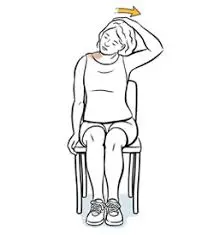
- Sitting in a chair position.
- With your right hand, hold on to the chair’s side.
- Maintain total relaxation in the shoulder.
- bending the entire body to the left.
- Next, tuck your chin in and down.
- Turn your head to the left.
- Put the left hand on the head’s right side.
- Compress downward.
- The right Rectus Capitis muscle should feel stretched.
- Hold for three repetitions of thirty seconds.
- On the other side, repeat.
Stretch to Capitis Muscle
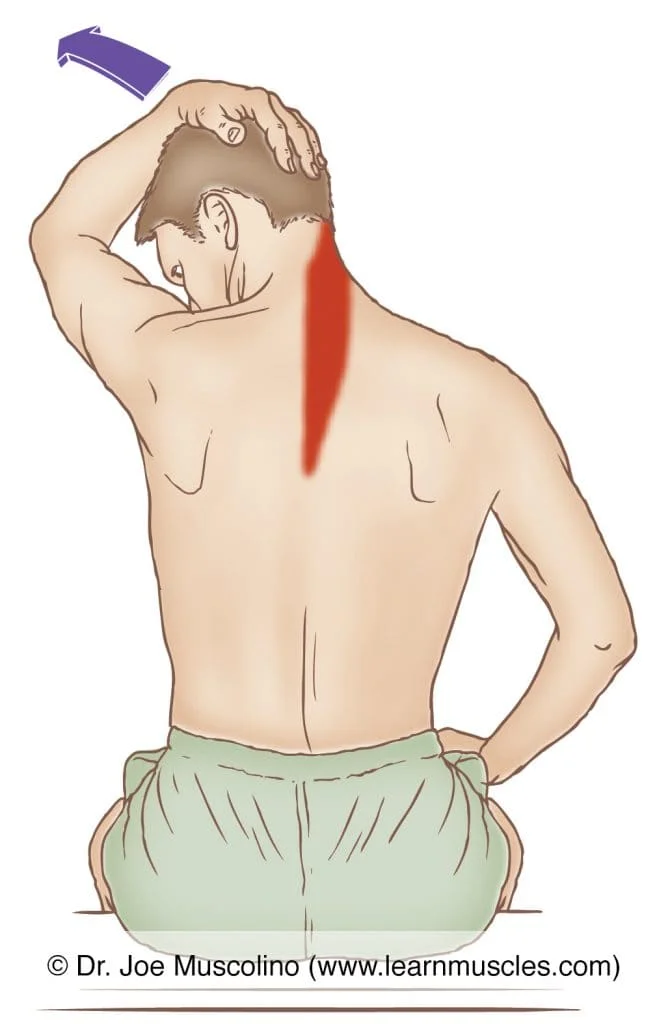
- Put your chin back and down.
- Rotate your head to the right.
- Place the right hand on the head’s other side.
- Compress downward.
- Turn the head slowly to the left.
- The left side of the Rectus Capitis muscle should feel a firm stretch.
- Hold for three repetitions of thirty seconds.
- On the other side, repeat.
Longus Capitis Muscle Stretch
Flexing the head and neck at the spinal joints stretches the longus capitis muscle, which is a member of the transversospinalis group.
The effectiveness of the stretch for the opposing-side longus capitis muscle will be increased by the prefix in lateral flexion, which is not evident in the accompanying demonstration.
You can hold for three to five repetitions and thirty to forty seconds
Stretch to Capitis Muscle
- Put your chin back and down.
- Rotate your head to the right.
- Place the right hand on the head’s other side.
- Compress downward.
- Turn the head slowly to the left.
- The left side of the Rectus Capitis muscle should feel a firm stretch.
- Hold for three repetitions of thirty seconds.
- On the other side, repeat.
Strengthening Exercise Longus capitis Muscle
Chin to chest Exercise
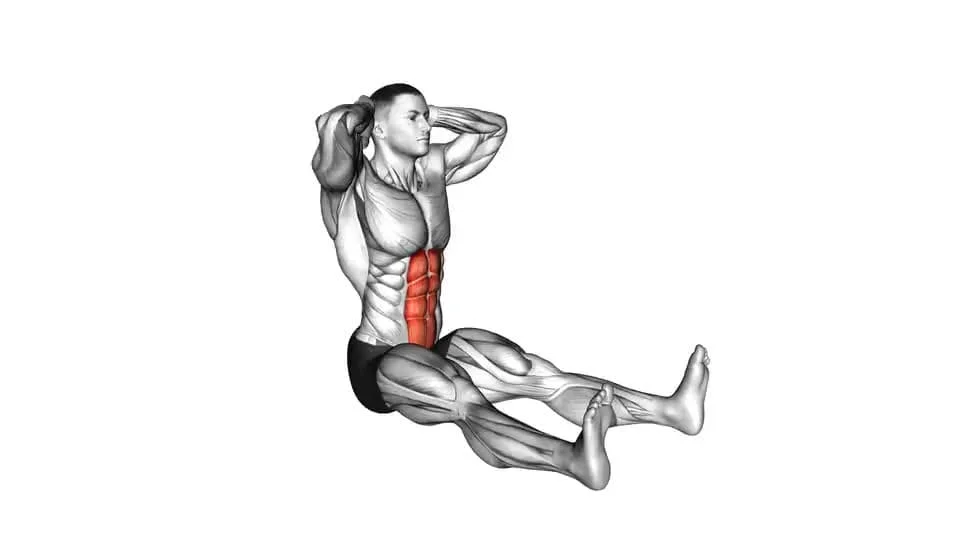
- Sit on the ground with your back to the wall. Place two hands with clasped fingers at the base of the head.
- thumbs pointing downward or elbows pointing forward.
- You can hold it for 20 to 30 seconds or perform the head down to the chest.
- Perform this exercise ten times.
Theraban Rows
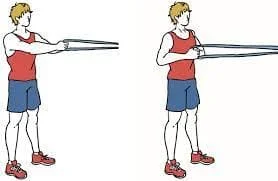
- Theraband should first be wrapped around a doorknob, knotted, and then closed within the door.
- The band rests on the chest.
- With the Theraband at each end in your hands, your knee slightly bent, and your abdominal muscles taut, you are standing tall.
- Squeezing the shoulder blades and neck muscular contraction together, maintaining the taut trunk muscles, and pulling the arms back is necessary.
- Instead of shrugging the shoulder joint up toward the ears, you are attempting to concentrate on compressing the shoulder blades.
- Then, without bending back, return to your starting posture.
- Hold this exercise position for ten seconds.
- Do this ten times in one session and three sessions every day
Head lifts
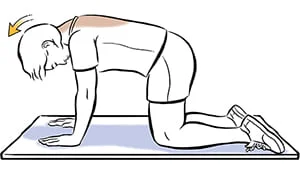
- Your arms are extended to the sides while you lie flat on your back.
Give a nod and tuck your chin in. - After a little period of holding this exercise, release it and return to a neutral position.
- Hold this exercise position for ten seconds.
- Do this ten times in one session and three sessions every day.
Seated Clasped Neck Stretch
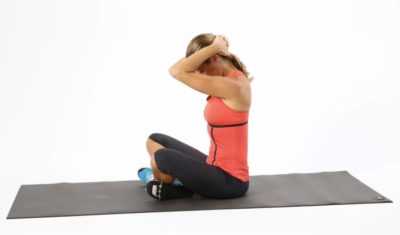
- You are seated on a chair and the floor with comfort.
- You have to arrange your body correctly.
- Next, clasp your hands and place both palms behind your head.
- Try to lower your chin into your chest and gradually press your hands down toward your thighs.
- For thirty seconds, stay in this stretched-out posture.
- Execute the three times in a single session and three times daily.
Isometric Neck extension exercise

- Take a comfortable seat and slowly move your head back to face upward without arching your back.
- Wait five to ten seconds. Return to the starting point.
- This is a good workout to do during the workday to avoid tension in the neck.
- Tension the neck muscles gently and hold for five to ten seconds.
- Repeat ten times while returning to a neutral position.
Isometric Neck Rotation exercise

- Start this exercise by rotating your head to one side while maintaining your chin at the same level and moving within reasonable bounds.
- For eight seconds, slowly extend and hold the neck muscles.
- Return the head to its neutral position and carry out the opposite direction.
- On each side, repeat ten times.
Revolved Triangle Exercise
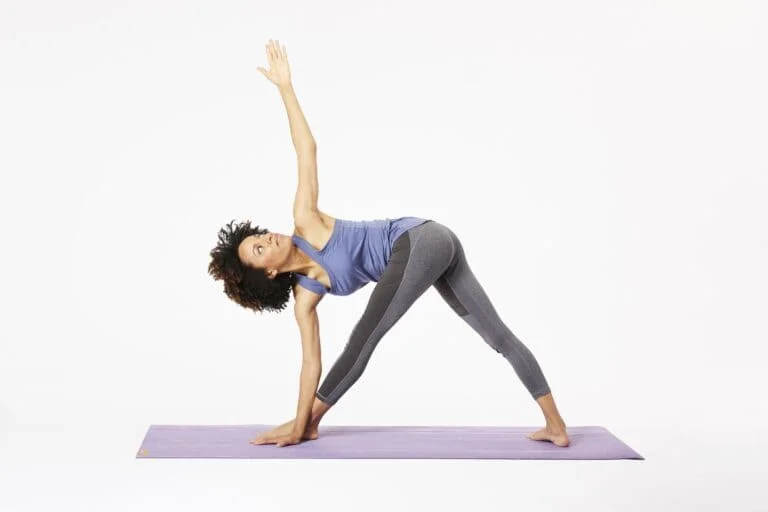
- Start this workout by placing your feet approximately four feet apart.
- With your left toe pointed out at a small angle, face your right toe forward.
Face forward and square your hips in the same direction as your right toes. - Raise your arms so that they are parallel to the ground at the sides.
When your torso is parallel to the floor, stop folding forward by slowly hinging at the hips. - Put your left hand as close as you can to your leg, the floor, or a block.
- Raise your right arm straight up, keeping your palm facing away from your body.
- Lift your eyes and look up near your right thumb.
- Release the breath to turn the neck and gaze at the surface below.
- turn back up and take a breath.
- As you hold this stance for up to a minute, keep your upper body steady and keep making these neck turns.
- Perform on the other side.
Upward Plank Exercise
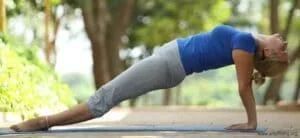
- Place yourself in a position of sitting with your legs straight in front of you.
- Alongside the hips, press the palms to the ground.
- Raise your hips and place your feet beneath your knees.
- Straighten your legs to deepen the position.
- Let the head fall back and open the chest.
- As long as 30 seconds, hold.
- Repeat this stance three times.
Prone Cobra Exercise
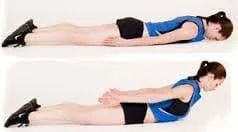
- This workout begins with you lying face down on the ground, using gravity as resistance.
- Lay face down on the ground, supporting your forehead with a towel wrapped over your hand.
- Place the arms sideways with the palms facing down on the ground.
- Slide the tongue across the mouth’s upper palate.
- Raise the hands off the ground by combining the shoulder blades.
- Turn the thumbs backward, the elbows inside, and the palms outside.
- Raise your forehead gently off the towel by approximately one inch while keeping your eyes fixed on the ground.
- Hold the posture for a duration of seven to ten seconds.
- Perform ten to seven reps.
Prone Rows Exercise
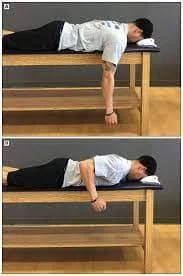
- With your arms hanging off the side of the bed, simply tilt your head such that it is turning the corner of the bed as you lie on your stomach.
- For comfort, place a pillow beneath your stomach. Begin by drawing your arms back, bending your elbows, and bringing your shoulder blades together.
- Retraction of the arms should not be combined with head elevation.
- Twenty times over, repeat. Execute twice daily.
Superman Exercise
- Practice this on a hard surface such as a mat. Lay flat on your stomach with your arms outstretched straight from your body.
- Both the arms and the legs should remain parallel to the ground.
- Elevate your arms and legs in unison, as though attempting to soar. clench your lower back. Make sure that breathing happens as it should.
- Hold the pose for two to five seconds per repetition, depending on your level of fitness. Aim for sets of two to three reps, 5 to 10 at a time.
- The amount of repetitions or sets a person can perform in a single session or day depends on their degree of fitness.
Seated Clasped Neck Stretch
- You are seated on a chair and the floor with comfort.
- You have to arrange your body correctly.
- Next, clasp your hands and place both palms behind your head.
- Try to lower your chin into your chest and gradually press your hands down toward your thighs.
- For thirty seconds, stay in this stretched-out posture.
- Execute the three times in a single session and three times daily.
Tilted forward flexion exercise
- Slowly tilt your head to the left. Apply pressure with the neck muscles using the left hand as resistance. Hold for five to ten seconds, then take a step back to the beginning.
- Moreover, tilt your head slowly to the opposite side. Wait five to ten seconds.
- Go back to where you were before. Perform ten iterations. This is a beneficial exercise to perform while at work, particularly if your job requires you to hold your head still for extended periods, like when using a computer. To assist prevent neck tightness, perform this exercise every half hour.
Conclusion
The erector spinae muscle group, which extends the entire length of the spine, includes the Longus capitis muscle. It enters into the mastoid process of the temporal bone after emerging from the transverse processes of the upper thoracic and lower cervical vertebrae.
The Longus capitis muscle aids in the lateral flexion and extension of the head and neck. It also helps to stabilize the spine and maintain proper posture. An essential muscle that supports the spine and is involved in several head and neck movements is the Longus capitis Muscle. Maintaining excellent posture and general musculoskeletal health depends on its proper function.
FAQ
What is the function of the capitis muscle?
One deep neck muscle is the splenius capitis. It comes from the superior third thoracic vertebrae, the lower half of the nuchal ligament, and the spinous processes of the seventh cervical vertebra. It rotates and flexes the neck laterally.
What is the longus capitis muscle known by another name?
The longus capitis muscle, also known as the rectus capitis anticus major in Latin, is the long muscle of the head. It is thick and broad above and narrow below. Using four tendinous slips, it rises convergently from the front tubercles of the transverse processes of the third, fourth, fifth, and sixth cervical vertebrae.
What are the symptoms of longus capitis muscle pain?
Headaches. Pain in the nape and back of the head is one sign of a longissimus capitis strain. Itching or numbness in the scalp. Another typical indicator and symptom of a longissimus capitis strain is stiffness in the neck.
What is longus capitis innervated by?
The anterior rami of the cervical plexus branches, spinal nerves C1–C3 and sometimes C4, innervate the longus capitis muscle.
How do you stretch the longus colli and capitis?
By extending and laterally flexing the head and neck at the spinal joints on the left side, one can stretch the right-side longus colli and longus capitis. By stretching and laterally flexing the head and neck at the spinal joints on the left side, one can stretch the right-side longus colli.
What is the difference between a longus and a brevis muscle?
It is said that the fibularis longus (FL) muscle is the stronger evertor of the two since it has a higher volume than the fibularis brevis (FB). Hindfoot eversion is significantly hampered by injury to the FB, as demonstrated by clinical observations of FL and FB tendon rupture.
What is the action of the longus?
Longus Colli has been demonstrated to have a postural effect on cervical curvature, counteracting the lordosis increment associated with the head’s weight and the activation of the posterior cervical muscles, in addition to working in tandem with the other cervical flexors to induce neck flexion.
How do you stretch the longus capitis?
Lay flat on your back and press your fingers just behind the jaw to feel the muscles at the front of your neck. Tuck your chin in gently and raise your head slightly, about 1 centimeter off the ground. After that, softly turn your neck a few centimeters to either side.
Why is it called Longus?
In Latin, the words longus and colli come from the root words for “long” and “neck,” respectively. Longus colli, when the two are combined, literally translates to “long neck.” The longus colli muscle is used in any workout or movement that flexes the neck forward and downward.
Reference
- Longus Capitis. (n.d.). Physiopedia. https://www.physio-pedia.com/Longus_Capitis
- Patel, J. (2023, December 13). Longus capitis muscle Origin, Insertion, Function, Exercise – Mobile. Mobile Physiotherapy Clinic. https://mobilephysiotherapyclinic.in/longus-capitis-muscle/

